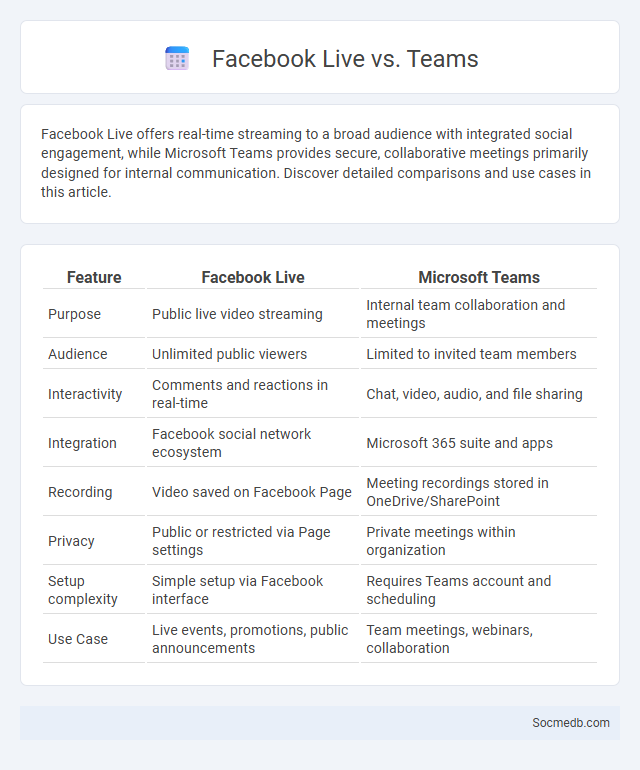
Photo illustration: Facebook Live vs Teams
Facebook Live offers real-time streaming to a broad audience with integrated social engagement, while Microsoft Teams provides secure, collaborative meetings primarily designed for internal communication. Discover detailed comparisons and use cases in this article.
Table of Comparison
| Feature | Facebook Live | Microsoft Teams |
|---|---|---|
| Purpose | Public live video streaming | Internal team collaboration and meetings |
| Audience | Unlimited public viewers | Limited to invited team members |
| Interactivity | Comments and reactions in real-time | Chat, video, audio, and file sharing |
| Integration | Facebook social network ecosystem | Microsoft 365 suite and apps |
| Recording | Video saved on Facebook Page | Meeting recordings stored in OneDrive/SharePoint |
| Privacy | Public or restricted via Page settings | Private meetings within organization |
| Setup complexity | Simple setup via Facebook interface | Requires Teams account and scheduling |
| Use Case | Live events, promotions, public announcements | Team meetings, webinars, collaboration |
Introduction: Understanding Live Streaming Platforms
Live streaming platforms revolutionize the way content is shared by offering real-time video broadcasting to global audiences. These platforms, such as Twitch, YouTube Live, and Facebook Live, enable creators to engage directly with viewers through interactive features like chat and reactions. Understanding live streaming platforms empowers you to leverage their potential for personal branding, community building, and business growth.
Key Features Comparison: Facebook Live, Teams, and General Live Streaming
Facebook Live offers real-time interaction with audience reactions and comments directly on the platform, enhancing engagement during broadcasts. Microsoft Teams integrates live streaming with collaboration tools like chat, file sharing, and scheduling, making it ideal for corporate and educational settings. Your choice depends on whether you need broad public reach with Facebook Live, professional collaboration with Teams, or general live streaming flexibility for diverse content platforms.
Audience Reach and Engagement
Social media platforms enable businesses to significantly expand their audience reach by targeting specific demographics and interests through advanced algorithms and ad targeting tools. Increased audience reach often correlates with higher engagement rates, including likes, shares, comments, and click-throughs, which are critical indicators of content relevance and brand loyalty. Optimizing content for each platform's unique user behavior and leveraging analytics can enhance engagement metrics and drive sustainable growth.
User Interface and Accessibility
A well-designed social media User Interface (UI) enhances user engagement by providing intuitive navigation, clear visual hierarchy, and responsive design across devices. Accessibility features such as screen reader compatibility, adjustable text sizes, and high-contrast modes ensure that Your experience is inclusive for users with disabilities. Prioritizing both UI and accessibility improves overall usability, making social platforms more welcoming and efficient for diverse audiences.
Integrations and Compatibility
Social media platforms offer extensive integrations with third-party applications, enhancing functionality through seamless connectivity with tools like CRM systems, marketing automation software, and analytics dashboards. Compatibility across various devices and operating systems ensures consistent user experiences, enabling real-time content sharing and engagement from smartphones, tablets, and desktops. Robust API support facilitates custom integrations, allowing businesses to tailor social media workflows to specific operational needs and improve overall digital marketing efficiency.
Security and Privacy Considerations
Social media platforms collect vast amounts of personal data, making your security and privacy vulnerable to breaches and unauthorized access. Implement strong passwords, enable two-factor authentication, and regularly review privacy settings to safeguard your information. Understanding the risks and actively managing your digital footprint helps protect your identity and personal content from cyber threats.
Customization and Branding Options
Social media platforms offer extensive customization and branding options that allow businesses to tailor their profiles with logos, brand colors, and unique content styles. These features enhance brand recognition and create a cohesive online identity across channels like Instagram, Facebook, and LinkedIn. Utilizing custom templates and targeted audience insights helps maximize engagement and strengthens brand loyalty.
Monetization and Analytics Tools
Social media platforms offer advanced monetization options such as ad revenue sharing, sponsored content, and subscription models that help you generate income from your audience. Powerful analytics tools track engagement metrics, audience demographics, and content performance to optimize your marketing strategy and maximize revenue. Leveraging these insights enables your brand to refine campaigns and increase conversion rates effectively.
Use Cases: Best Platforms for Different Scenarios
Businesses aiming to reach younger audiences can leverage TikTok's viral video format for brand awareness and product launches. LinkedIn excels for B2B networking, professional development, and recruiting top talent, making it ideal for corporate outreach. Your choice of platform should align with your specific goals, whether it's Instagram for visual storytelling or Twitter for real-time news and engagement.
Conclusion: Choosing the Right Live Streaming Solution
Selecting the right live streaming solution enhances Your social media presence by ensuring high-quality video, reliable performance, and audience engagement features. Evaluating factors like platform compatibility, analytics tools, and cost-effectiveness empowers informed decisions that align with Your content goals. Investing in the optimal live streaming service drives stronger interaction and growth across Your social media channels.
 socmedb.com
socmedb.com